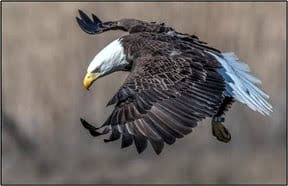The bald eagle population in New Jersey continues to climb, according to the 2022 New Jersey Bald Eagle Project Report developed by the New Jersey Department of Environmental Protection (DEP) Division of Fish and Wildlife and the Conserve Wildlife Foundation of New Jersey, with 250 active nests identified in 2022, DEP Commissioner Shawn M. LaTourette announced on Jan. 20.
The 250 active nests (meaning the nests produced eggs) represent an increase of 28 active nests since 2021. Of those nests, 83% were successful and collectively produced 335 offspring. The productivity rate for nests with known outcomes was 1.42 young per nest, which is above the range required to maintain healthy population numbers, according to a press release.
“The continued growth of New Jersey’s bald eagle population is an inspiration to all of us and is a direct result of strong environmental protection laws, firm partnerships, innovative scientific techniques and the dedication of many volunteers who devote much of their time to monitoring and protecting eagles,” said LaTourette.
“The efforts of the New Jersey Bald Eagle Project – a partnership among the DEP, Conserve Wildlife Foundation of New Jersey and volunteer eagle watchers – demonstrate how new technologies, effective coordination, public engagement and education are at work to protect treasured wildlife species such as the bald eagle,” the DEP commissioner said.
“The ongoing recovery and growth of New Jersey’s bald eagle population is a remarkable story that gets better with each passing year,” said Fish and Wildlife Assistant Commissioner Dave Golden. “Conservation efforts such as protecting sensitive eagle nesting and wintering areas, engaging and educating the public, and tracking eagles’ movements have all contributed to the enormous success of the program that will continue to conserve New Jersey’s wildlife for future generations to enjoy.”
The 250 active nests confirmed in 2022 represent a more than two-fold increase over the 10-year period beginning in 2013, when 119 active nests were counted. The Delaware Bay region remained the state’s eagle stronghold, with roughly half of all nests located in Cumberland and Salem counties and the bayside of Cape May County, according to the press release.
A total of 267 total territorial pairs were monitored in 2022. This number includes pairs that had active nests as well as those that maintained nest territories but did not lay eggs. Fourteen new territorial nesting sites were confirmed in the southern region, 10 in the central and five in the north, according to the press release.
“New Jersey continues to collect high quality data on the health and productivity of its bald eagles, which is no small feat given the species’ ever-growing numbers. Other states increasingly look to New Jersey’s volunteer-based monitoring program as a guiding example of how to monitor this species efficiently and effectively in this latest stage of its recovery. It is a fitting moment to recognize these successes, as the Endangered Species Act, which supported this inspiring recovery, now celebrates 50 years,” said U.S. Fish and Wildlife Service Northeast Eagle Coordinator Thomas Wittig.
New Jersey had just one surviving bald eagle nest into the 1970s and 1980s – a pair in a remote part of Cumberland County – due to widespread use of DDT. This synthetic insecticide had lasting impacts on the food chain, accumulating in fish that eagles eat and causing eagles to lay thin-shelled eggs that could not withstand incubation. The federal government banned DDT in 1972, according to the press release.
Recovery efforts in New Jersey began in the early 1980s with reintroduction of eagles from Canada and artificial incubation and fostering efforts; efforts that started to pay discernible dividends throughout the 1990s.
The federal government removed the bald eagle from its list of endangered species in 2007, reflecting strong gain in the population throughout the nation, according to the press release.
The current bald eagle protection status in New Jersey, however, remains state-endangered during the breeding season and state-threatened for the non-breeding season. The greatest threats to bald eagles in New Jersey are disruptive human activity in nesting and foraging areas, and habitat loss.
DEP Endangered and Nongame Species Program biologists work throughout the year to reduce disturbances to nests by coordinating with a team of volunteer nest observers, providing guidance to landowners on how to protect eagle habitat, identifying land for acquisition and management, applying the state’s land use regulations, and educating the public, according to the press release.
Goals of the New Jersey Bald Eagle Project include monitoring the bird’s recovery status in the state; protecting nesting sites, foraging and wintering areas; documenting location data to identify at-risk habitats; and providing education to private landowners.
Biologists and Conserve Wildlife Foundation staff work with volunteer observers to monitor nests, report sightings and protect critical habitat to support the continued growth of the state’s bald eagle population, according to the press release.
For more information about the New Jersey Bald Eagle Project, visit Conserve Wildlife Foundation of New Jersey’s website at http://www.conservewildlifenj.org/protecting/projects/baldeagle/ and at the DEP’s website at https://dep.nj.gov/njfw/wildlife/raptors-in-new-jersey/#eagle.

